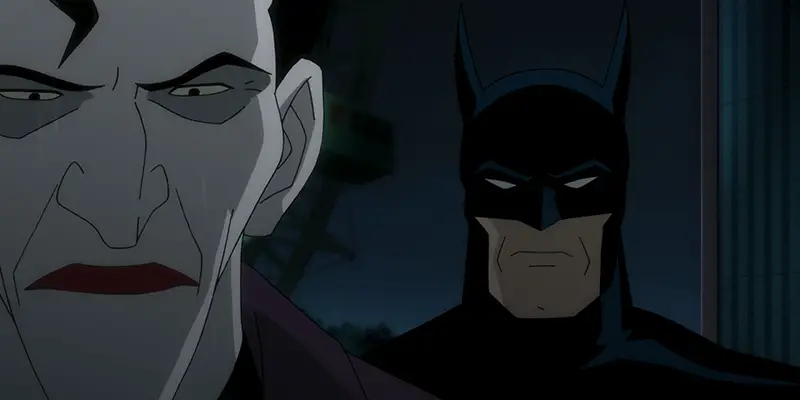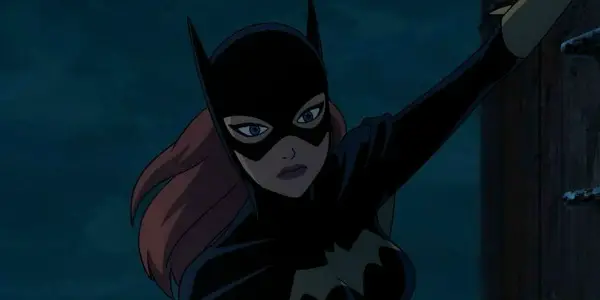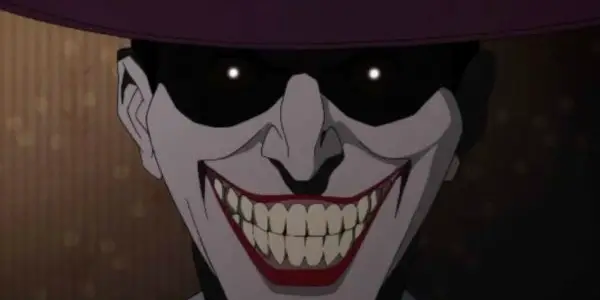BATMAN: THE KILLING JOKE: Fan Favorites Conroy And Hamill Return In This Controversial Piece

Zachary is studying film at the University of Southern California,…
When I signed on to review Batman: The Killing Joke, it was before its San Diego Comic-Con debut. As soon as that screening ended, there was a massive wave of discontent (in some cases, rage) over certain creative decisions made by the filmmakers. It would be remiss of me to not address these issues, which I’ll divide into three camps and address below.
The film is the latest entry in the DC animated universe movie (direct-to-video) franchise, started back in 2007 with the DVD release of Superman Doomsday, and its eventual Blu-ray release, along with the rest of the films, from Batman: Gotham Knight on.
The Killing Joke pulls from the vast pool of talent that have worked on these films and the DC animated universe television shows, dating back to 1992, with the groundbreaking Batman: The Animated Series. This film comes directed by Sam Liu, a DC animation veteran, with directing credits including many DCAU TV shows and movies, among them Green Lantern: The Animated Series, All-Star Superman, and Justice League vs. Teen Titans.
The screenplay is an adaptation penned by Brian Azzarello, from a comic written by Alan Moore and illustrated by Brain Bolland. A huge attracting factor of the film is the return of the magnificent, longtime voice actors for Batman and The Joker, Kevin Conroy and Mark Hamill.
Both Conroy and Hamill are able to show new shades of their characters; likewise, rarely explored aspects of both characters come to light in The Killing Joke. With Batman, there’s an evaluation on the part of his dynamic with The Joker, and with the Clown Prince of Crime, we see sides of the character (from the Red Hood days) which are rarely displayed. This is one of the film’s pleasing aspects.
A Breakdown Of Batgirl
On the note of pleasing aspects, there is one of the film’s first half standouts: Batgirl, voiced by voice-over legend, Tara Strong. Here I’ll begin to address the controversy the film has been met with. I am unsure whether or not the changes the film made from its source material (namely, the decision to amp up the amount of Batgirl in the first half, leading to it feeling like a Batgirl film for part of the run-time) are to be attributed to the screenwriter Azzarello, the film’s director Sam Liu, or others on the creative team.
Those who know the comic know what happens with Batgirl a.k.a. Barbara Gordon, and while it is odd to have the film take a sharp turn from Batgirl focus to Batman focus, it is nice to have her onscreen at all. I’ve always enjoyed the character, and here we see her grappling with new-to-superheroing issues, like when a criminal gets too attached (something the older, more seasoned Batman in this piece is accustomed to).
There is a tricky power dynamic at play here between Barbara and Bruce; they are partners, but not equal, separated by years and experience. Bruce is protective of her, while she cares deeply for him.

This is where the main deviation from the source material comes in. Of the three issues mentioned at the start of this, there is the first: the extra Batgirl in the film. Then the second: the sexual pairing of Batgirl and Batman (not Barbara and Bruce). The action immediately preceding the, well, action, is one of my favorites from the piece.
Batgirl lashes out in frustration against Batman, who is barring her from pursuing a case. He, at first, successfully deflects each hit from her, but then she gains the upper hand – unexpectedly so. She pins him to the ground, and what could have allowed the scene to continue to resonate would have been their reactions. He’d be surprised she prevailed in her attack, she’d be potentially upset by what she had done, having been taken over by her frustration.
Instead, the now-infamous sex scene follows. Despite the fact that the film is rated R, it smartly chooses to shy away from showing any of this directly (a choice the film also wisely makes later on with some horrible acts committed by The Joker). When Batgirl’s costume comes off, the moment is laughable, if the uproar from the audience at the theatrical showing I attended is any indication.
It’s understandable that any deviation from the source material be upsetting to fans, especially with how these films are known for directly adapting comic story-lines, and being able to do so without limiting content for kids – the films are all PG-13 or R.
It’s even more understandable that this particular deviation be upsetting, given that it can be interpreted to reducing a female character to a love interest, or using a female character as a plot device, potentially aimed at increasing emotional connections between the audience and Batgirl before tragedy strikes.
In any case, the decision is not one I agree with, and it didn’t belong in the film. I am fine with more Batgirl, but if the talent was okay amping up her role and adding the romance, why not make more changes to the story-line? Why not delay or alter Barbara’s fate? It’s a slippery slope, one that could have been avoided by sticking to the material.
Killing Joke Controversy
The third camp of complaints aimed at the film is related to a larger, ongoing discourse. Violence towards women on-screen in TV and film is being cross-examined, and many audience members are choosing to not support works with such violence. I understand the underlying sentiment.
I love few things in films and TV more than fight scenes – I do not, however, tend to enjoy the brutalization of characters on-screen, male or female. That said, the source material is where the violence towards Barbara comes from. Horrible acts of depravity occur, and images of the results are used to torture Commissioner Gordon.
The perpetrator of these acts is none other than The Joker. If such individuals are to appear in fiction, then they are likely to be depicted committing such acts – and choosing to avoid such media is a personal one. I myself hated seeing Batgirl horrifically attacked. I prefer seeing her take down the bad guys, often two times her size.
There are two sides to cinema: it can show us idealized images, those that inspire us and empower us, and then there is the other side, that of our worst nightmares, things we don’t necessarily want to see. This is no different than the real world. There is plenty of good, and plenty of bad. Film and TV should not be restricted from showing either.

What no doubt tends to be overlooked by some of those attacking this film is the source material, and that things like this is what The Joker is bound to do. Such content isn’t found in the DC animated TV shows; likewise, it is absent from shows like the ceaselessly empowering and optimistic Supergirl TV show, heading to The CW in its second season.
There are programs out there for all kinds of audiences, even within the DC universe. There’s even a girl-centric series of comics and an animated show coming, focused on the DC Super Hero Girls. My point being, that this film’s treatment of its female characters is not the be-all end-all, and some of this treatment is inherited from the comic book by the same name.
Controversy aside, the talent involved is able to shine. This is the first of these films that I’ve been able to see on a big screen, and the animation (outside of some CG-aided shots that were limited by the budget) and sound were fantastic in a large theater.
The film did extremely well with its limited theatrical run, so it’s unlikely that we won’t see more DCU films coming to theaters in the near future. DC veteran composers Kristopher Carter, Michael McCuistion and Lolita Ritmanis know well how to lend gravitas and excitement to the proceedings, and the voice talent are all rock solid.
Voice Acting Icons
Kevin Conroy manages to carve out a different Batman from his previous performances, while retaining that signature sound that brings on heavy, grin-inducing nostalgia – as does Mark Hamill. While Hamill brings that Joker sound, he also humanizes the character (via the screenplay), which this reviewer is unsure how to feel about.
While it is a commendable achievement to make such a character humanized, it doesn’t seem right, given his actions in The Killing Joke. Regardless, it is compelling, particularly in the film’s final moments.
Some of the controversy surrounding The Killing Joke is deserved, and should be taken into consideration by the creative talent, as they plan upcoming DCU films. Controversy aside, DCU films will need to give this one a look, if anything for the continued, astonishing talents of Kevin Conroy and Mark Hamill – two extremely well-casted and seasoned performers, excelling in roles they’ve all but owned since first playing them back in the early ’90s.
Conclusion
Whether you think you can get past the controversy or not, I recommend giving The Killing Joke a look for yourself. The voice talent, animation, and scoring worked wonderfully in a theatrical environment, so they’ll no doubt be great when viewed at home.
Odd deviations from the source material aside, the inordinately talented folks at DC Animation deliver another great film. If you’ve enjoyed their previous efforts, and if you’ve ever watched any DC projects with Conroy and Hamill lending their vocal performances, then you’ll get something out of this one.
What do you think about The Killing Joke‘s deviations from its source material?
Batman: The Killing Joke is now available on Blu-ray, DVD, and VOD.
Does content like this matter to you?
Become a Member and support film journalism. Unlock access to all of Film Inquiry`s great articles. Join a community of like-minded readers who are passionate about cinema - get access to our private members Network, give back to independent filmmakers, and more.
Zachary is studying film at the University of Southern California, in Los Angeles. He is enamored with blockbuster films (both the hits and the flops) and the tech, toys and tools that go into making them. He aspires to bring an indie sensibility to big films in his career as a writer/director/actor, and looks to writer/director/actors like Jon Favreau and Ben Affleck for inspiration. He is notorious for appreciating films that the masses seem to loathe, and loves film scores and composers. While he loves the big movies, he also loves a good indie (and shouting to the heavens above about said indie). He may or may not have a penchant for collecting Blu-rays, and when not writing/making/talking/reading/listening to film-related material, he likes to do other stuff... like watch TV (and perhaps other things as well).













